Business Economics Essay: Monopoly and Inefficiency in Australian Post
VerifiedAdded on 2023/04/21
|10
|2073
|267
Essay
AI Summary
This essay provides an analysis of the monopoly market structure, focusing on the characteristics, advantages, and disadvantages of such a market. It delves into the specifics of the Australian Post as a case study, highlighting its legal monopoly in delivering standard letters and the implications of this power, including price manipulation and restricted competition. The essay also addresses the inefficiencies inherent in a monopoly market, such as allocative and productive inefficiencies, and the role of regulatory bodies like the ACCC in controlling monopoly power. It concludes by emphasizing the need for government intervention to ensure fair market outcomes and protect consumer interests, particularly in the context of the evolving postal service landscape.
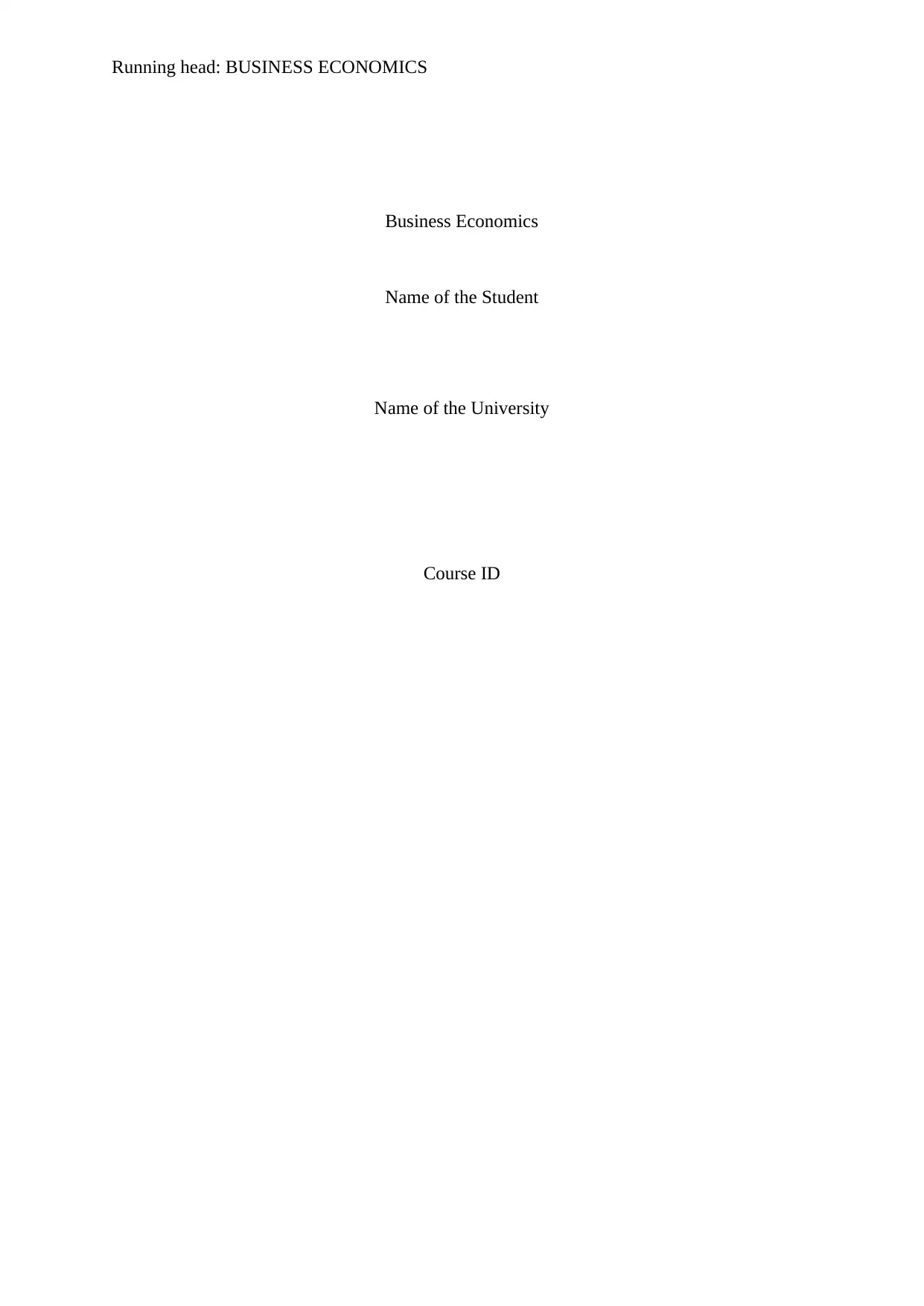
Running head: BUSINESS ECONOMICS
Business Economics
Name of the Student
Name of the University
Course ID
Business Economics
Name of the Student
Name of the University
Course ID
Paraphrase This Document
Need a fresh take? Get an instant paraphrase of this document with our AI Paraphraser
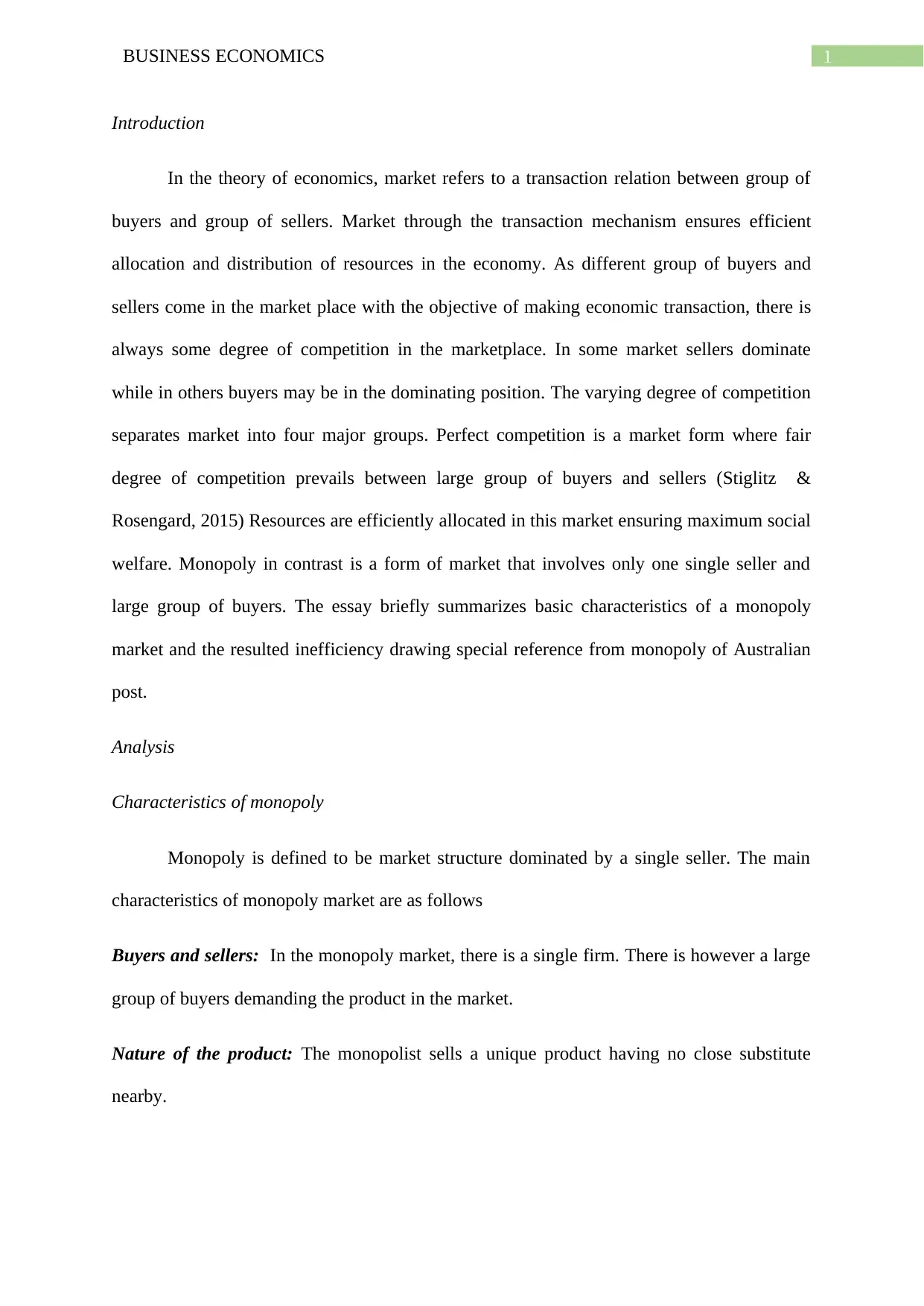
1BUSINESS ECONOMICS
Introduction
In the theory of economics, market refers to a transaction relation between group of
buyers and group of sellers. Market through the transaction mechanism ensures efficient
allocation and distribution of resources in the economy. As different group of buyers and
sellers come in the market place with the objective of making economic transaction, there is
always some degree of competition in the marketplace. In some market sellers dominate
while in others buyers may be in the dominating position. The varying degree of competition
separates market into four major groups. Perfect competition is a market form where fair
degree of competition prevails between large group of buyers and sellers (Stiglitz &
Rosengard, 2015) Resources are efficiently allocated in this market ensuring maximum social
welfare. Monopoly in contrast is a form of market that involves only one single seller and
large group of buyers. The essay briefly summarizes basic characteristics of a monopoly
market and the resulted inefficiency drawing special reference from monopoly of Australian
post.
Analysis
Characteristics of monopoly
Monopoly is defined to be market structure dominated by a single seller. The main
characteristics of monopoly market are as follows
Buyers and sellers: In the monopoly market, there is a single firm. There is however a large
group of buyers demanding the product in the market.
Nature of the product: The monopolist sells a unique product having no close substitute
nearby.
Introduction
In the theory of economics, market refers to a transaction relation between group of
buyers and group of sellers. Market through the transaction mechanism ensures efficient
allocation and distribution of resources in the economy. As different group of buyers and
sellers come in the market place with the objective of making economic transaction, there is
always some degree of competition in the marketplace. In some market sellers dominate
while in others buyers may be in the dominating position. The varying degree of competition
separates market into four major groups. Perfect competition is a market form where fair
degree of competition prevails between large group of buyers and sellers (Stiglitz &
Rosengard, 2015) Resources are efficiently allocated in this market ensuring maximum social
welfare. Monopoly in contrast is a form of market that involves only one single seller and
large group of buyers. The essay briefly summarizes basic characteristics of a monopoly
market and the resulted inefficiency drawing special reference from monopoly of Australian
post.
Analysis
Characteristics of monopoly
Monopoly is defined to be market structure dominated by a single seller. The main
characteristics of monopoly market are as follows
Buyers and sellers: In the monopoly market, there is a single firm. There is however a large
group of buyers demanding the product in the market.
Nature of the product: The monopolist sells a unique product having no close substitute
nearby.
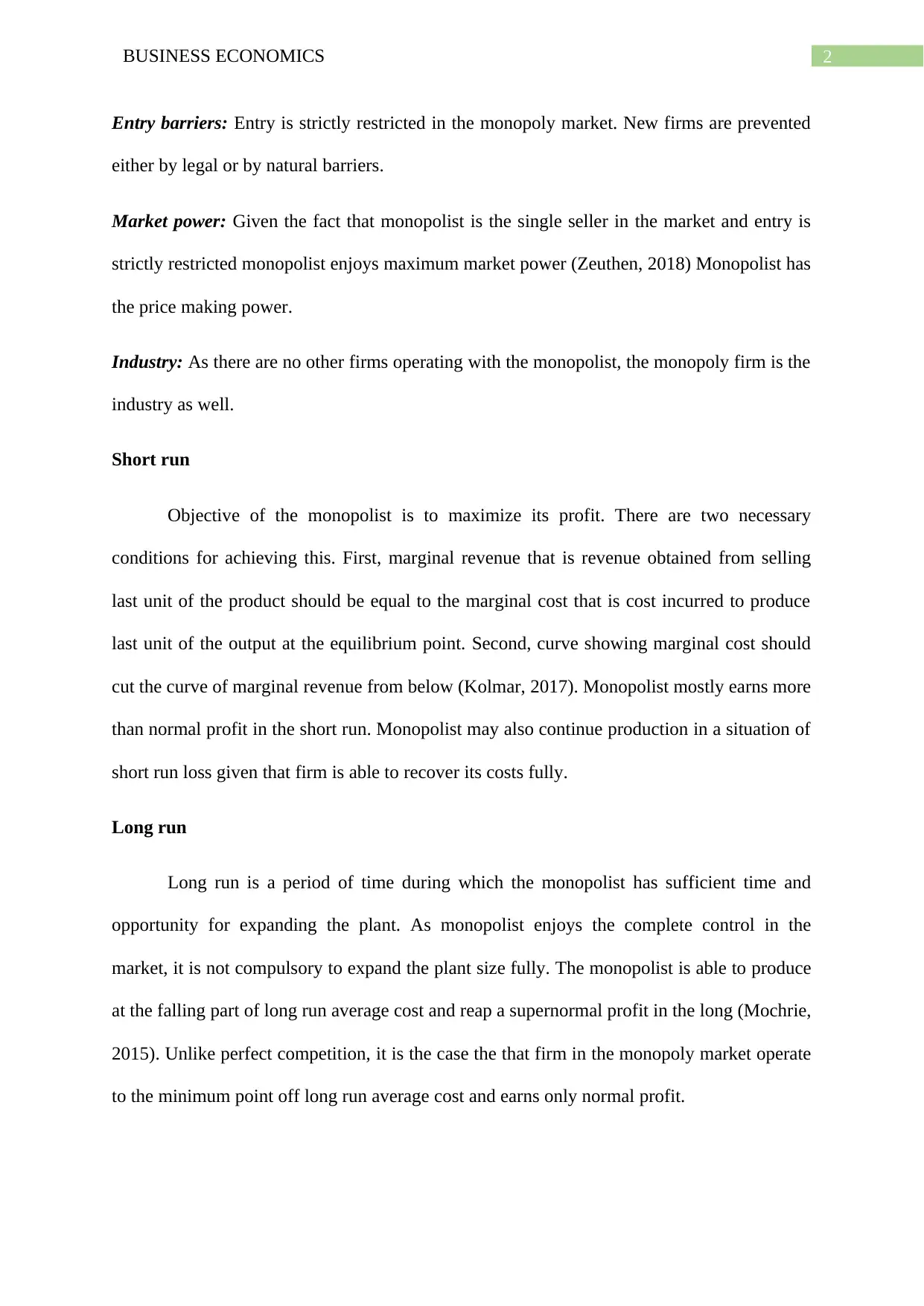
2BUSINESS ECONOMICS
Entry barriers: Entry is strictly restricted in the monopoly market. New firms are prevented
either by legal or by natural barriers.
Market power: Given the fact that monopolist is the single seller in the market and entry is
strictly restricted monopolist enjoys maximum market power (Zeuthen, 2018) Monopolist has
the price making power.
Industry: As there are no other firms operating with the monopolist, the monopoly firm is the
industry as well.
Short run
Objective of the monopolist is to maximize its profit. There are two necessary
conditions for achieving this. First, marginal revenue that is revenue obtained from selling
last unit of the product should be equal to the marginal cost that is cost incurred to produce
last unit of the output at the equilibrium point. Second, curve showing marginal cost should
cut the curve of marginal revenue from below (Kolmar, 2017). Monopolist mostly earns more
than normal profit in the short run. Monopolist may also continue production in a situation of
short run loss given that firm is able to recover its costs fully.
Long run
Long run is a period of time during which the monopolist has sufficient time and
opportunity for expanding the plant. As monopolist enjoys the complete control in the
market, it is not compulsory to expand the plant size fully. The monopolist is able to produce
at the falling part of long run average cost and reap a supernormal profit in the long (Mochrie,
2015). Unlike perfect competition, it is the case the that firm in the monopoly market operate
to the minimum point off long run average cost and earns only normal profit.
Entry barriers: Entry is strictly restricted in the monopoly market. New firms are prevented
either by legal or by natural barriers.
Market power: Given the fact that monopolist is the single seller in the market and entry is
strictly restricted monopolist enjoys maximum market power (Zeuthen, 2018) Monopolist has
the price making power.
Industry: As there are no other firms operating with the monopolist, the monopoly firm is the
industry as well.
Short run
Objective of the monopolist is to maximize its profit. There are two necessary
conditions for achieving this. First, marginal revenue that is revenue obtained from selling
last unit of the product should be equal to the marginal cost that is cost incurred to produce
last unit of the output at the equilibrium point. Second, curve showing marginal cost should
cut the curve of marginal revenue from below (Kolmar, 2017). Monopolist mostly earns more
than normal profit in the short run. Monopolist may also continue production in a situation of
short run loss given that firm is able to recover its costs fully.
Long run
Long run is a period of time during which the monopolist has sufficient time and
opportunity for expanding the plant. As monopolist enjoys the complete control in the
market, it is not compulsory to expand the plant size fully. The monopolist is able to produce
at the falling part of long run average cost and reap a supernormal profit in the long (Mochrie,
2015). Unlike perfect competition, it is the case the that firm in the monopoly market operate
to the minimum point off long run average cost and earns only normal profit.
⊘ This is a preview!⊘
Do you want full access?
Subscribe today to unlock all pages.

Trusted by 1+ million students worldwide

3BUSINESS ECONOMICS
Figure 1: Long run profit in monopoly market
Monopoly in Australian post
Postal service in Australia has characteristics similar to that under a monopoly. It is a
company that delivers parcels and letter across Australia. Australian post is statutory
monopoly authority enjoying monopoly right in delivery of letter weighting less than 250
grams. The delivery cost of letters is less than $2.40. In the monopoly market legal or
regulatory barriers work as a tool of entry restriction. This is particularly relevant for
Australian post. It is Australian government who restricts entry of any new firms in the
market creating an environment for legalized monopoly.
In an economy, the monopoly power of a firm might be derived from four primary
sources. First, exclusive ownership of a firm over a specific resource extremely important for
the industry. Second, high fixed cost making it socially feasible for one firm to serve the
industry (Leigh & Triggs, 2016) Third, network externality in the market. Fourth, legal
barrier restricting entry of new firms. The last one is relevant for Australian post. In turn of
Figure 1: Long run profit in monopoly market
Monopoly in Australian post
Postal service in Australia has characteristics similar to that under a monopoly. It is a
company that delivers parcels and letter across Australia. Australian post is statutory
monopoly authority enjoying monopoly right in delivery of letter weighting less than 250
grams. The delivery cost of letters is less than $2.40. In the monopoly market legal or
regulatory barriers work as a tool of entry restriction. This is particularly relevant for
Australian post. It is Australian government who restricts entry of any new firms in the
market creating an environment for legalized monopoly.
In an economy, the monopoly power of a firm might be derived from four primary
sources. First, exclusive ownership of a firm over a specific resource extremely important for
the industry. Second, high fixed cost making it socially feasible for one firm to serve the
industry (Leigh & Triggs, 2016) Third, network externality in the market. Fourth, legal
barrier restricting entry of new firms. The last one is relevant for Australian post. In turn of
Paraphrase This Document
Need a fresh take? Get an instant paraphrase of this document with our AI Paraphraser

4BUSINESS ECONOMICS
the legal grant to exercise monopoly, the company has some obligations to meet. It has the
responsibility to deliver letters and parcels to the various region of Australia at a cheaper rate
(accc.gov.au, 2018). Government mandates that it should make deliveries to ninety-eight
percent of the addresses five times in each week. The minimum number of outlets that
Australian post need to have is combining regions located in remote as well as rural areas.
An obvious implication of monopoly of Australian post is limiting competition in
postal market. The small private companies are prevented to enter the market and to deliver
parcel to the post office boxes. This hurts the small business willing to enter the industry.
Competition among the sellers ensure that goods are delivered at the minimum efficient price.
Control of a single firm also hurts Australia consumers in terms of preventing them from
paying a fair market price (Jaag, Moyano & Trinkner, 2016 The fair market price can only
be determined from competition among buyers and sellers. In the absence of any degree of
competition, the Australian post abuses its market power and sustain its own control in the
service market of parcel delivery. It is only Australian post and its associated subsidiary those
can deliver parcel in Australia.
An important feature of monopoly market is its power to make price in the market.
Monopolist can increase market power any time (McKenzie & Lee, 2016) As monopolist
increases market price, consumers of postal service get hurt. With the claim of recovering
loss, Australian post in recent years has attempted to increase postage rate for business mail
delivery and also proposed some changes in the off-peak rates. The monopoly power to
exploit price and quantity prevents the market from having a socially optimal market
outcome.
With the advent of internet and online delivery services Australian post faces sudden
decline in the delivery of physical mail and parcel (Parcu & Silvestri, 2017) The reduced
the legal grant to exercise monopoly, the company has some obligations to meet. It has the
responsibility to deliver letters and parcels to the various region of Australia at a cheaper rate
(accc.gov.au, 2018). Government mandates that it should make deliveries to ninety-eight
percent of the addresses five times in each week. The minimum number of outlets that
Australian post need to have is combining regions located in remote as well as rural areas.
An obvious implication of monopoly of Australian post is limiting competition in
postal market. The small private companies are prevented to enter the market and to deliver
parcel to the post office boxes. This hurts the small business willing to enter the industry.
Competition among the sellers ensure that goods are delivered at the minimum efficient price.
Control of a single firm also hurts Australia consumers in terms of preventing them from
paying a fair market price (Jaag, Moyano & Trinkner, 2016 The fair market price can only
be determined from competition among buyers and sellers. In the absence of any degree of
competition, the Australian post abuses its market power and sustain its own control in the
service market of parcel delivery. It is only Australian post and its associated subsidiary those
can deliver parcel in Australia.
An important feature of monopoly market is its power to make price in the market.
Monopolist can increase market power any time (McKenzie & Lee, 2016) As monopolist
increases market price, consumers of postal service get hurt. With the claim of recovering
loss, Australian post in recent years has attempted to increase postage rate for business mail
delivery and also proposed some changes in the off-peak rates. The monopoly power to
exploit price and quantity prevents the market from having a socially optimal market
outcome.
With the advent of internet and online delivery services Australian post faces sudden
decline in the delivery of physical mail and parcel (Parcu & Silvestri, 2017) The reduced

5BUSINESS ECONOMICS
volume of mail delivery reduces profit. In many situations as claimed by the postal company,
it might incur a loss. A monopolist in the long run never operates in a market resulting in
long term economic loss. One way to recover loss is to increase price and restores economic
profit. Australian post aims to attain this by increasing rate of postal services. In additional to
an increase price of business mail service, price has been also price has also increases for pre-
sort services serving wholesale customers (accc.gov.au, 2018). The Australian competition
and consumer commission (ACCC) has revealed the proposition of price increase in order to
escape from the projected loss.
Monopoly inefficiency
The monopoly market is an efficient form of market. Neither allocative nor
productive efficiency are attained with the extremely high market power. The allocative
inefficiency arises from the fact that price is charged above the marginal cost. The productive
inefficiency arises as monopolist mostly operates to the left of minimum average cost in the
long run (Sloman & Jones, 2017) The figure below compares monopoly market outcome to
that of a competitive efficient outcome and resulted welfare loss under monopoly.
volume of mail delivery reduces profit. In many situations as claimed by the postal company,
it might incur a loss. A monopolist in the long run never operates in a market resulting in
long term economic loss. One way to recover loss is to increase price and restores economic
profit. Australian post aims to attain this by increasing rate of postal services. In additional to
an increase price of business mail service, price has been also price has also increases for pre-
sort services serving wholesale customers (accc.gov.au, 2018). The Australian competition
and consumer commission (ACCC) has revealed the proposition of price increase in order to
escape from the projected loss.
Monopoly inefficiency
The monopoly market is an efficient form of market. Neither allocative nor
productive efficiency are attained with the extremely high market power. The allocative
inefficiency arises from the fact that price is charged above the marginal cost. The productive
inefficiency arises as monopolist mostly operates to the left of minimum average cost in the
long run (Sloman & Jones, 2017) The figure below compares monopoly market outcome to
that of a competitive efficient outcome and resulted welfare loss under monopoly.
⊘ This is a preview!⊘
Do you want full access?
Subscribe today to unlock all pages.

Trusted by 1+ million students worldwide
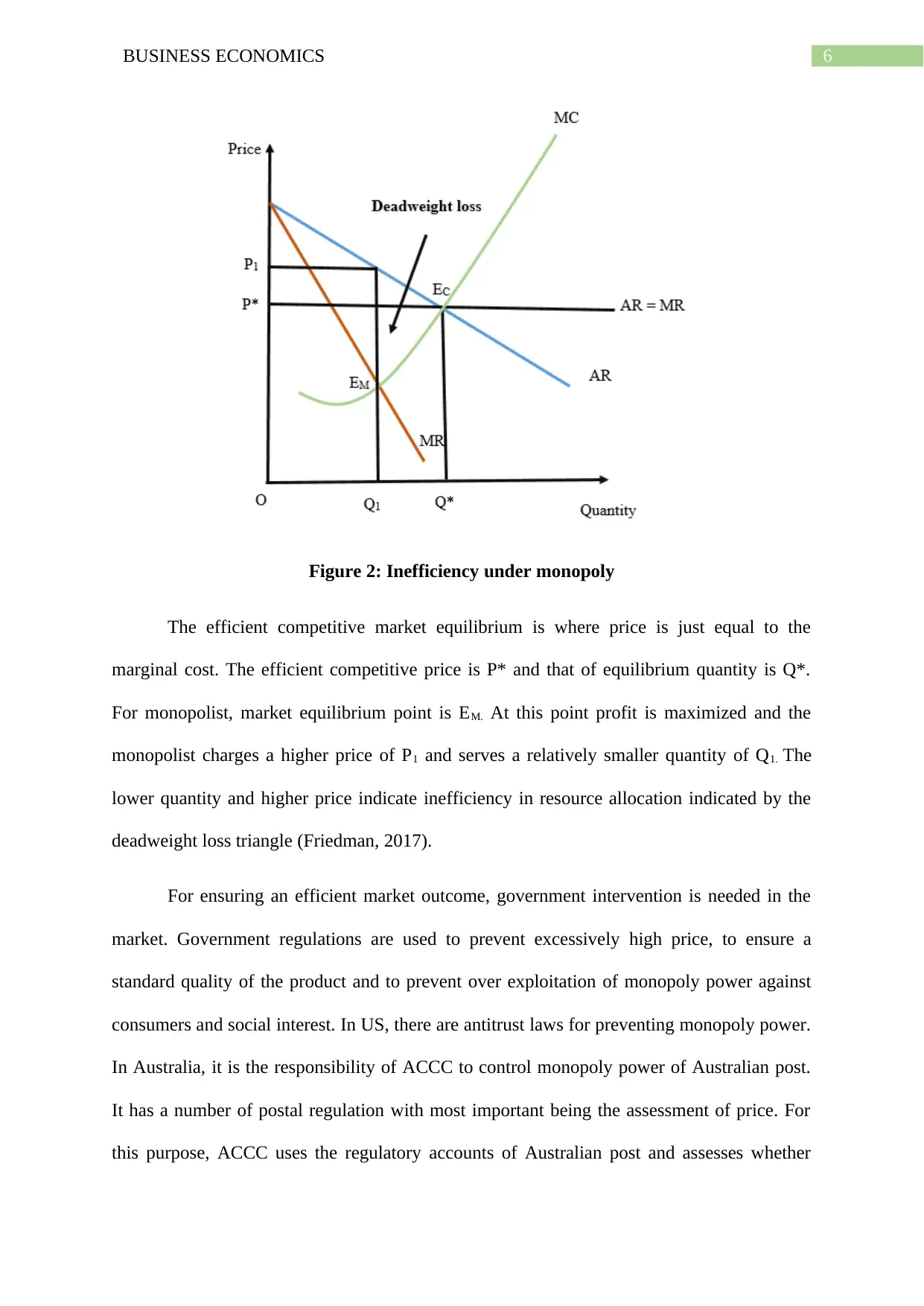
6BUSINESS ECONOMICS
Figure 2: Inefficiency under monopoly
The efficient competitive market equilibrium is where price is just equal to the
marginal cost. The efficient competitive price is P* and that of equilibrium quantity is Q*.
For monopolist, market equilibrium point is EM. At this point profit is maximized and the
monopolist charges a higher price of P1 and serves a relatively smaller quantity of Q1. The
lower quantity and higher price indicate inefficiency in resource allocation indicated by the
deadweight loss triangle (Friedman, 2017).
For ensuring an efficient market outcome, government intervention is needed in the
market. Government regulations are used to prevent excessively high price, to ensure a
standard quality of the product and to prevent over exploitation of monopoly power against
consumers and social interest. In US, there are antitrust laws for preventing monopoly power.
In Australia, it is the responsibility of ACCC to control monopoly power of Australian post.
It has a number of postal regulation with most important being the assessment of price. For
this purpose, ACCC uses the regulatory accounts of Australian post and assesses whether
Figure 2: Inefficiency under monopoly
The efficient competitive market equilibrium is where price is just equal to the
marginal cost. The efficient competitive price is P* and that of equilibrium quantity is Q*.
For monopolist, market equilibrium point is EM. At this point profit is maximized and the
monopolist charges a higher price of P1 and serves a relatively smaller quantity of Q1. The
lower quantity and higher price indicate inefficiency in resource allocation indicated by the
deadweight loss triangle (Friedman, 2017).
For ensuring an efficient market outcome, government intervention is needed in the
market. Government regulations are used to prevent excessively high price, to ensure a
standard quality of the product and to prevent over exploitation of monopoly power against
consumers and social interest. In US, there are antitrust laws for preventing monopoly power.
In Australia, it is the responsibility of ACCC to control monopoly power of Australian post.
It has a number of postal regulation with most important being the assessment of price. For
this purpose, ACCC uses the regulatory accounts of Australian post and assesses whether
Paraphrase This Document
Need a fresh take? Get an instant paraphrase of this document with our AI Paraphraser
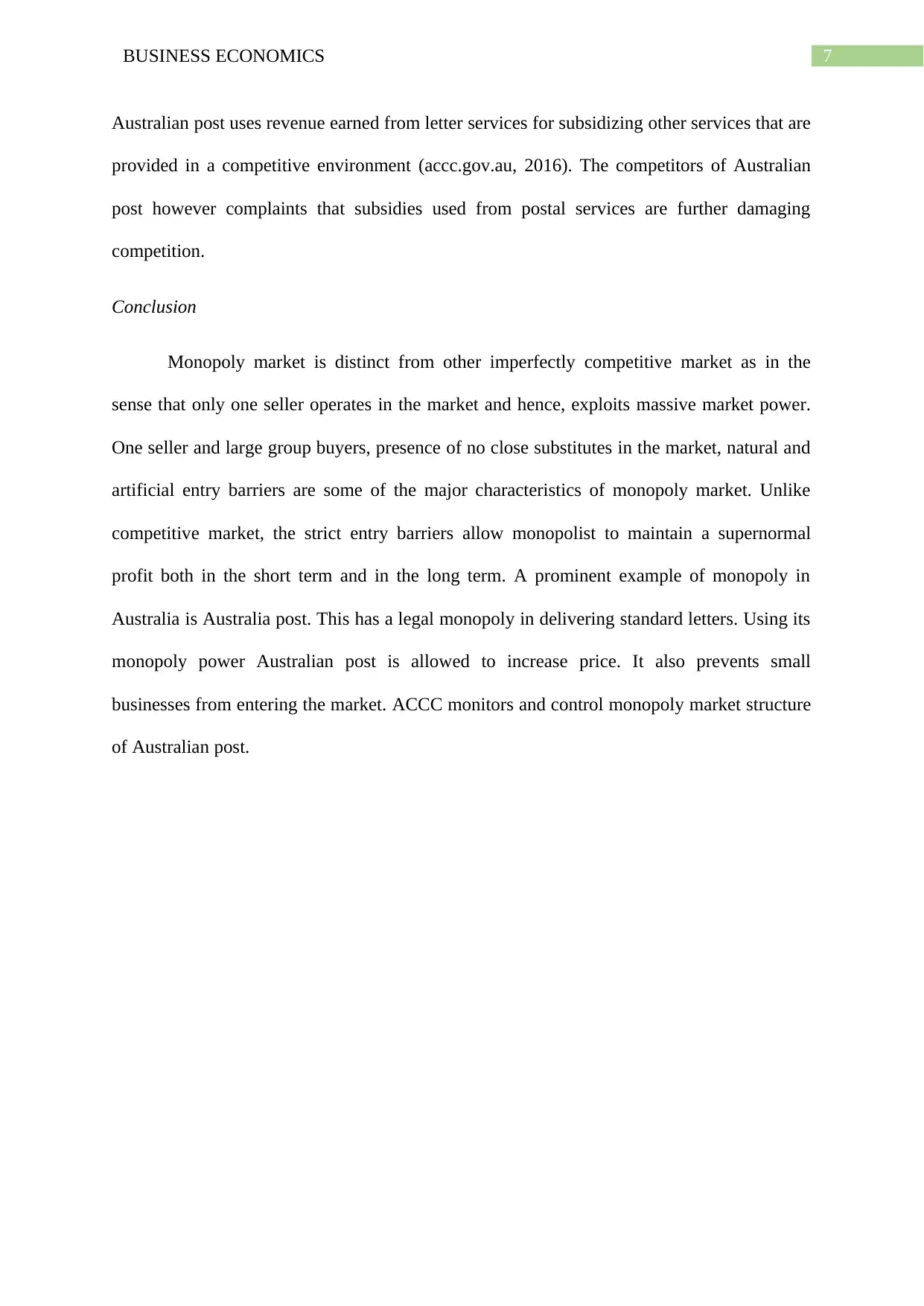
7BUSINESS ECONOMICS
Australian post uses revenue earned from letter services for subsidizing other services that are
provided in a competitive environment (accc.gov.au, 2016). The competitors of Australian
post however complaints that subsidies used from postal services are further damaging
competition.
Conclusion
Monopoly market is distinct from other imperfectly competitive market as in the
sense that only one seller operates in the market and hence, exploits massive market power.
One seller and large group buyers, presence of no close substitutes in the market, natural and
artificial entry barriers are some of the major characteristics of monopoly market. Unlike
competitive market, the strict entry barriers allow monopolist to maintain a supernormal
profit both in the short term and in the long term. A prominent example of monopoly in
Australia is Australia post. This has a legal monopoly in delivering standard letters. Using its
monopoly power Australian post is allowed to increase price. It also prevents small
businesses from entering the market. ACCC monitors and control monopoly market structure
of Australian post.
Australian post uses revenue earned from letter services for subsidizing other services that are
provided in a competitive environment (accc.gov.au, 2016). The competitors of Australian
post however complaints that subsidies used from postal services are further damaging
competition.
Conclusion
Monopoly market is distinct from other imperfectly competitive market as in the
sense that only one seller operates in the market and hence, exploits massive market power.
One seller and large group buyers, presence of no close substitutes in the market, natural and
artificial entry barriers are some of the major characteristics of monopoly market. Unlike
competitive market, the strict entry barriers allow monopolist to maintain a supernormal
profit both in the short term and in the long term. A prominent example of monopoly in
Australia is Australia post. This has a legal monopoly in delivering standard letters. Using its
monopoly power Australian post is allowed to increase price. It also prevents small
businesses from entering the market. ACCC monitors and control monopoly market structure
of Australian post.
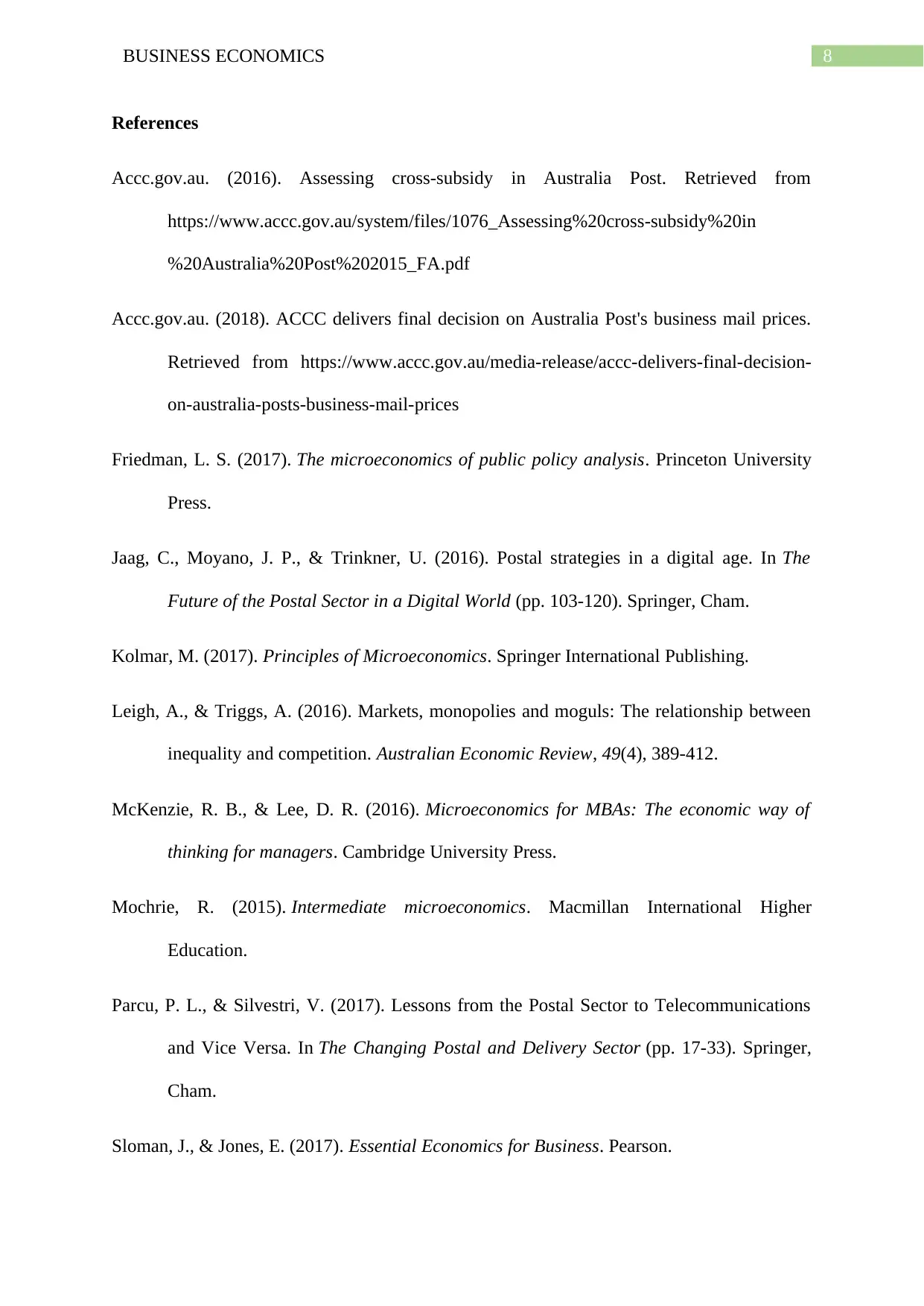
8BUSINESS ECONOMICS
References
Accc.gov.au. (2016). Assessing cross-subsidy in Australia Post. Retrieved from
https://www.accc.gov.au/system/files/1076_Assessing%20cross-subsidy%20in
%20Australia%20Post%202015_FA.pdf
Accc.gov.au. (2018). ACCC delivers final decision on Australia Post's business mail prices.
Retrieved from https://www.accc.gov.au/media-release/accc-delivers-final-decision-
on-australia-posts-business-mail-prices
Friedman, L. S. (2017). The microeconomics of public policy analysis. Princeton University
Press.
Jaag, C., Moyano, J. P., & Trinkner, U. (2016). Postal strategies in a digital age. In The
Future of the Postal Sector in a Digital World (pp. 103-120). Springer, Cham.
Kolmar, M. (2017). Principles of Microeconomics. Springer International Publishing.
Leigh, A., & Triggs, A. (2016). Markets, monopolies and moguls: The relationship between
inequality and competition. Australian Economic Review, 49(4), 389-412.
McKenzie, R. B., & Lee, D. R. (2016). Microeconomics for MBAs: The economic way of
thinking for managers. Cambridge University Press.
Mochrie, R. (2015). Intermediate microeconomics. Macmillan International Higher
Education.
Parcu, P. L., & Silvestri, V. (2017). Lessons from the Postal Sector to Telecommunications
and Vice Versa. In The Changing Postal and Delivery Sector (pp. 17-33). Springer,
Cham.
Sloman, J., & Jones, E. (2017). Essential Economics for Business. Pearson.
References
Accc.gov.au. (2016). Assessing cross-subsidy in Australia Post. Retrieved from
https://www.accc.gov.au/system/files/1076_Assessing%20cross-subsidy%20in
%20Australia%20Post%202015_FA.pdf
Accc.gov.au. (2018). ACCC delivers final decision on Australia Post's business mail prices.
Retrieved from https://www.accc.gov.au/media-release/accc-delivers-final-decision-
on-australia-posts-business-mail-prices
Friedman, L. S. (2017). The microeconomics of public policy analysis. Princeton University
Press.
Jaag, C., Moyano, J. P., & Trinkner, U. (2016). Postal strategies in a digital age. In The
Future of the Postal Sector in a Digital World (pp. 103-120). Springer, Cham.
Kolmar, M. (2017). Principles of Microeconomics. Springer International Publishing.
Leigh, A., & Triggs, A. (2016). Markets, monopolies and moguls: The relationship between
inequality and competition. Australian Economic Review, 49(4), 389-412.
McKenzie, R. B., & Lee, D. R. (2016). Microeconomics for MBAs: The economic way of
thinking for managers. Cambridge University Press.
Mochrie, R. (2015). Intermediate microeconomics. Macmillan International Higher
Education.
Parcu, P. L., & Silvestri, V. (2017). Lessons from the Postal Sector to Telecommunications
and Vice Versa. In The Changing Postal and Delivery Sector (pp. 17-33). Springer,
Cham.
Sloman, J., & Jones, E. (2017). Essential Economics for Business. Pearson.
⊘ This is a preview!⊘
Do you want full access?
Subscribe today to unlock all pages.

Trusted by 1+ million students worldwide
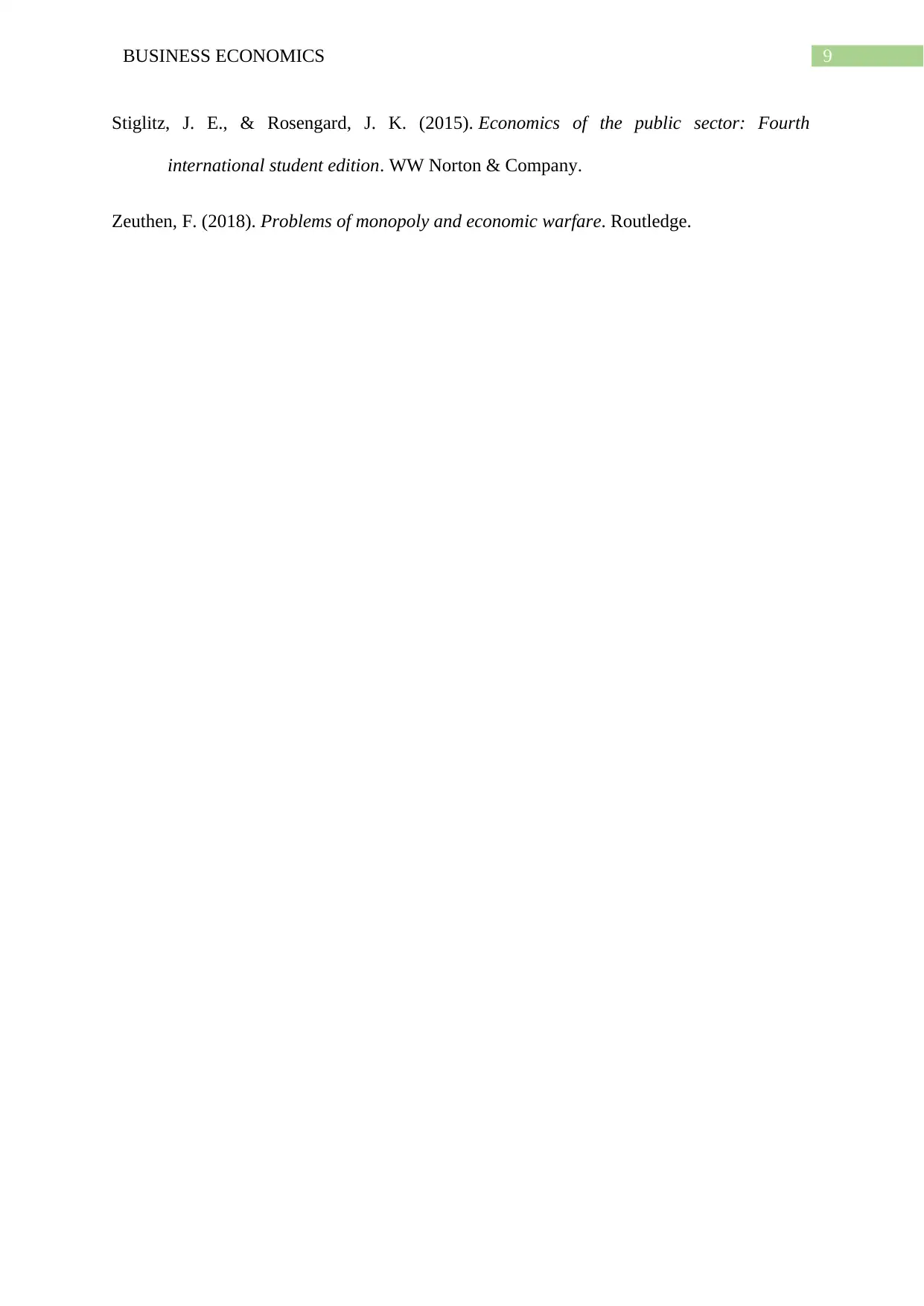
9BUSINESS ECONOMICS
Stiglitz, J. E., & Rosengard, J. K. (2015). Economics of the public sector: Fourth
international student edition. WW Norton & Company.
Zeuthen, F. (2018). Problems of monopoly and economic warfare. Routledge.
Stiglitz, J. E., & Rosengard, J. K. (2015). Economics of the public sector: Fourth
international student edition. WW Norton & Company.
Zeuthen, F. (2018). Problems of monopoly and economic warfare. Routledge.
1 out of 10
Related Documents
Your All-in-One AI-Powered Toolkit for Academic Success.
+13062052269
info@desklib.com
Available 24*7 on WhatsApp / Email
![[object Object]](/_next/static/media/star-bottom.7253800d.svg)
Unlock your academic potential
Copyright © 2020–2026 A2Z Services. All Rights Reserved. Developed and managed by ZUCOL.





